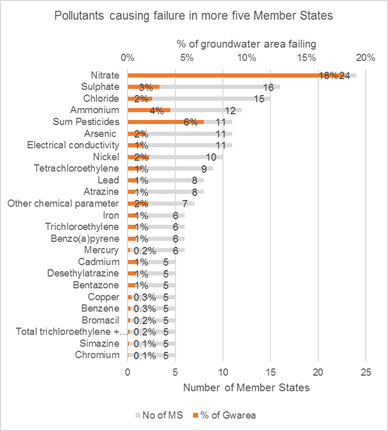Post a comment on the text below
Pollutants causing failure to achieve good status
In total, 160 chemicals were reported as causing poor chemical status. Some of these (iron, potassium, bicarbonate, calcium, magnesium, sodium and hardness) may be considered by some countries to characterise the natural background conditions of the aquifer and so in those places are not necessarily classified as anthropogenic pollutants. Electrical conductivity may be attributed to saline intrusions, where freshwater abstraction draws in saltwater, as only Member States with coastal areas reported this as a reason for failure.
The main pollutant causing failure to achieve good chemical status is nitrate. “Pesticides” are also reported as causing a large number of failures of good chemical status. Nitrate is the predominant groundwater pollutant throughout the EU (reported by 24 Member States causing failure in 18 % of groundwater area) (figure 4.3). Pesticides cause failure in 6.5 % of the groundwater bodies (by area).
Figure 4.3 Substances causing failure to achieve good chemical status in at least five Member States.

<needs to be updated with corrected EEA_00-00-0 other parameter & to change ”Sum pesticides” to ”Pesticides”>
Note: Pollutants causing failure in at least five Member States, shown by % of total GWB area
Source: Preliminary results based on WISE-SoW database including data from 25 Member States (EU28 except Greece, Ireland and Lithuania).
The list of substances most frequently leading to groundwater bodies not achieving good chemical status is dominated by substances used in agriculture (e.g. nitrate) and arising from salt intrusion (e.g. chloride). In addition, some industrial chemicals e.g. tetrachloroethylene, and metals arising from e.g. mining, contaminated sites and waste water, such as arsenic, nickel and lead, are causes of failure to achieve good chemical status.
|
Further and detailed information on groundwater pollutants including threshold values is available in WISE · Number and name of groundwater pollutants per Member State Table - TableEU - Graph |
You cannot post comments to this consultation because you are not authenticated. Please log in.



Previous comments
"Some of these (iron, potassium, bicarbonate, calcium, magnesium, sodium and hardness) may be considered by some countries to characterise the natural background conditions of the aquifer and so in those places are not necessarily classified as anthropogenic pollutants."
If thats the case, Art. 4.4 a(iii) of the WFD matches! "natural conditions do not allow timely improvement in the status of the body of water".
The report should include information about the bias that nitrates and pesticides are the substances which have to be monitored and assessed in all Member States.
In reference to the sentence starting with "Contaminated industrial sites, waste sites and old mines": In the European Union, a vast majority of aggregates extraction sites are dealing with inert materials such as sand, gravel and crushed rock, and produce inert wastes according to EU definitions and criteria included in EU Directives. The industry’s production process and treatment plants do not include the use of chemicals, as in most of the cases the processes are based on mechanical crushing, milling, grinding, and size grading. The Aggregates Industry does not represent a threat for water quality. It is necessary to make a clear distinction between the concept of mining and quarrying, as the nature of their activities and the properties of the materials they extract are very different. Arsenic, nickel, lead and copper are present in very few sites in Europe, it is therefore important to avoid that a mention to very rare and specific problem is extended to most of the sites that are managing inert materials. It is therefore essential to define clearly in the report what is meant by mining. As mining sites counting for less than 5% in comparison with quarries, sand and gravel extraction sites representing 95%, it would be recommended to clearly define which measures apply to mining and which ones to the Aggregates Industry rather than addressing the entire extractive industry.
BE-FLA (WV): p. 47. Fig. 4.3 “other chemical parameter”
This is a non-defined pollutant, so what is the relevance?
SK: Page 47, Figure 4.3: Adjust title and legend for “Gwarea” to be more understandable in the chart.
SK: Page 47, 1st paragraph: There is a chloride mentioned as an example in the first sentence. Is Cl also problematic in landlocked countries? If so, please explain the sources.
Could you precise what does GWB Area (km2) means (in text or tables) or make reference to 1.2 - Surface water and groundwater, if total GWB area is considered . In graph, % of groundwater area failing is making reference to the total area of at least five MS or to the mean of proportions of national GWB area of MS (maybe more relevant indicator)?
Tertrachlorethylene seems to be frequently used also as a solvent, including for households, and for dry cleaning